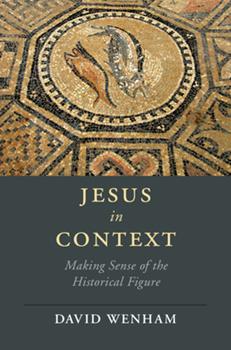Of the making of books on the historical Jesus there is no end, and one can be forgiven when the P.R. for a particular book on this subject sounds more like hype than a fair and balanced study of one of the most important persons in all of human history. In this case however, David Wenham has produced one of the very best assessments of the historical Jesus ever in print. It is fair, it is balanced, it is not a mere exercise in apologetics, it takes seriously the significant differences between the Gospel accounts and also fairly assesses the early extra Biblical evidence about the historical Jesus, chiefly in Josephus and Tacitus. Furthermore, it is well written, and is written at a level that the educated lay person, clergy, as well as students of the Bible and of ancient history can understand what is being said and profit from the time spent in reading the book. This book is written by a mature scholar who has spent a goodly portion of his scholar career and work on the Gospels, including on the historical issues they raise. He knows the scope of the scholarly work done on the Gospels and he has read widely, including reading some of the more salient recent studies on Jesus. My one wish is that his bibliography was more extensive, because this book is an excellent candidate to be a required book for an Introductory course on the historical Jesus or on the Gospels. This book should also be read by every teacher of the Gospels, and every pastor.
Jesus in Context is divided into two main parts— Part I–Setting the Scene, and Part II Jesus’ Life, Ministry, and Teaching: Context and History. Throughout the book what we find is careful analysis of the data and a proper stressing on how important understanding the context is to understanding the content of the Gospels. Unlike some books of this sort, David spends about equal time on the person and the work of Jesus, not reducing Jesus to a talking head, like in the Gospel of Thomas, but not neglecting some detailed analysis of Jesus’ wisdom speech ranging from riddles to aphorisms and maxims to narrative parables. Nor does he gloss over the miracle narratives, paying attention even to the exorcism stories found only in the Synoptics. Also unlike some modern treatments he does not minimize the strong opposition Jesus faced from some Jews particularly the Sadducees of the family of the high priest in charge of the temple complex, while also stressing that the Pharisaic response to Jesus was mixed. His portrait of Pilate, an unsavory and often anti-Semitic figure, is on target as well.
Naturally enough, in a book of only about 240 pages one could wish for more analysis, but the chapters in this book are just the right length to keep the reader interested and continuing to read, and as I suggested this book can work well as an Introductory offering in college or seminary courses on the subject. Kudos to Cambridge for persuading David to do this book. It represents one of best books of its kind about an important ancient historical figure who is still influencing our lives today. In the dialogue with David that follows this review, much more will be discussed.













